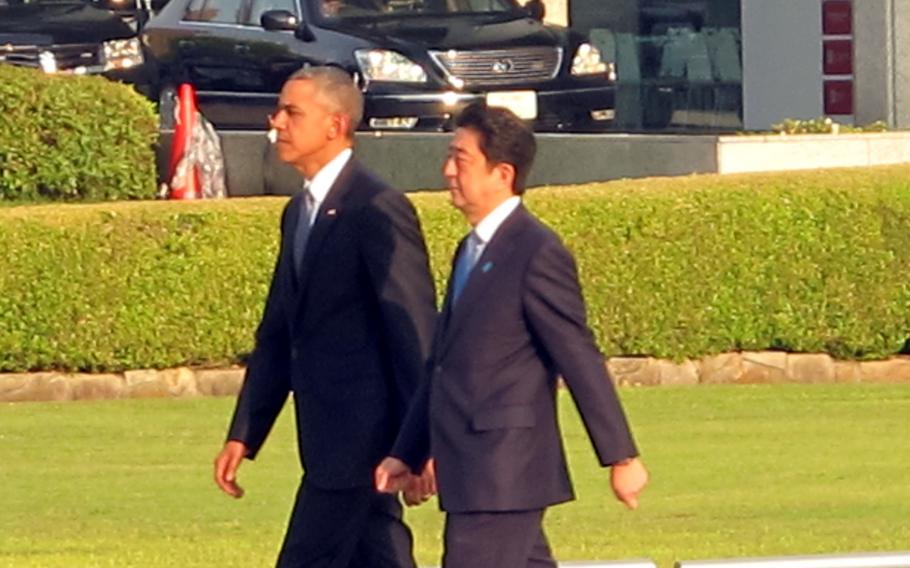
President Barack Obama and Japan Prime Minister Shinzo Abe arrive at Hiroshima Peace Memorial Park on May 27, 2016.Obama called on the world to pursue a long-term vision of a nuclear-free world Friday, as he became the first U.S. president ever to visit a Hiroshima memorial dedicated to those died in the world’s first wartime atomic bombing. (Erik Slavin/Stars and Stripes)
HIROSHIMA, Japan — President Barack Obama called on the world to pursue a long-term vision of a nuclear-free world Friday, as he became the first U.S. president ever to visit a Hiroshima memorial dedicated to those died in the world’s first wartime atomic bombing.
Obama and Japan Prime Minister Shinzo Abe each laid wreaths at a memorial to those who died in the 1945 bombing, as survivors of the attack and their families looked on.
“We come to ponder the terrible force unleashed in the no-so-distant past,” Obama said. “We come to mourn the dead.
“We stand here in the middle of this city and force ourselves to imagine the moment the bomb fell,” Obama said.
Obama noted that the dead included Japanese families, Koreans and American prisoners of war.
“Their souls speak to us,” Obama said. “They ask us to look inward, take stock of who we are, and what we might become.”
Much of Obama’s roughly 20-minute speech addressed the folly of war and a hope that humanity would progress to a point where it could eliminate atomic weapons, though he conceded that such a moment may not happen during his lifetime.
Obama also called for active measures to keep nuclear technology out of the wrong hands, in a thinly veiled reference to terror groups and North Korea, which has conducted nuclear tests despite condemnation from the world community.
“We can stop the spread to new nations and secure materiel from fanatics,” Obama said.
At the G7 summit on Wednesday, Obama and leaders of the world’s largest economies discussed ways to deter North Korea from further developing its nuclear program.
In response, North Korea on Thursday slammed Obama’s visit to Hiroshima – a trip generally greeted warmly by the world – as a “childish political calculation” of a “nuclear criminal.”
Following the ceremony, Obama and Abe each spoke to some of the hibakusha, the name given to survivors of the Hiroshima and Nagasaki bombings.
Shigeaki Mori, 79, who survived the attack as an 8-year-old, gave Obama a hug after speaking with him.
Obama’s call for reductions in the world’s nuclear stockpile has remained a theme throughout his presidency.
Less than four months into his first term, Obama gave a speech in Prague where he pledged the U.S. would “take concrete steps towards a world without nuclear weapons.”
The Nobel committee later cited his words as a factor in awarding Obama the Nobel Peace Prize.
However, Obama said in that same speech the U.S. would continue to maintain a smaller, but effective arsenal to deter adversaries.
Obama had planned to sign an arms reduction treaty with Russia, but that plan collapsed following Russia’s annexation of part of Ukraine.
His administration has also advocated modernizing the nation’s aging nuclear arsenal in a decades-long process that would cost hundreds of billions of dollars at current rates.
Official visits to the park by U.S. dignitaries began in 2010, when former U.S. Ambassador to Japan John Roos first participated in a memorial ceremony.
Current ambassador Caroline Kennedy has also visited, as did Secretary of State John Kerry in April.
On Aug. 6, 1945, the B-29 aircraft Enola Gay dropped an atomic bomb on Hiroshima, killing tens of thousands of people instantly and eventually killing many others due to related sickness and injuries.
Three days later, the U.S. dropped a second bomb on Nagasaki, while the Soviet Union invaded Japan-held Manchuria.
On Aug. 15, 1945, Japan announced its surrender, bringing an end to World War II.
Japan has since maintained its current security alliance with the U.S. since 1960 and hosts approximately 54,000 U.S. military personnel.
“The United States and Japan have forged not only an alliance, but a friendship that has one far more for our people then we could ever claim in war,” Obama said Friday.
Abe added during his speech that a strong alliance honored the memory of those who died in the atomic blast, and that Obama’s visit ushered in a new era of reconciliation between the U.S. and Japan.
Stars and Stripes reporter Yoo-kyong Chang contributed to this report.